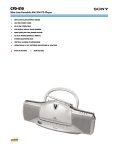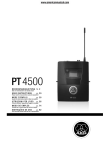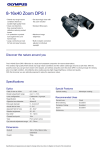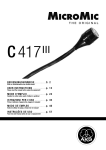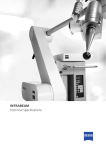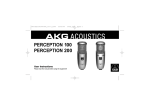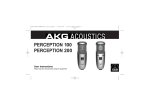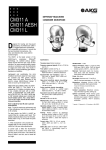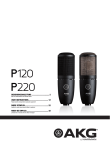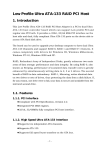Download bedienungsanleitung ................................. 2 user
Transcript
P420 BEDIENUNGSANLEITUNG ................................. 2 Bitte vor Inbetriebnahme des Gerätes lesen! USER INSTRUCTIONS ..................................... 14 Please read the manual before using the equipment! MODE D’EMPLOI............................................ 26 Veuillez lire cette notice avant d’utiliser le système! MODO DE EMPLEO......................................... 38 ¡Sirvase leer el manual antes de utilizar el equipo! Table of Contents Table of Contents 1 Safety and the environment ............................................................. 15 Environment ....................................................................................... 15 2 Description ....................................................................................... 16 Introduction ........................................................................................ 16 Contents ............................................................................................ 16 Optional Accessories........................................................................... 16 Short description ................................................................................ 16 Features............................................................................................. 17 3 Connecting to Audio Equipment ....................................................... 18 General .............................................................................................. 18 Pinout ................................................................................................ 18 Connecting the Microphone ................................................................. 18 4 Operation .......................................................................................... 19 Operating instructions ......................................................................... 19 Selecting Polar Patterns ...................................................................... 20 5 Cleaning ........................................................................................... 21 Microphone ........................................................................................ 21 6 Troubleshooting................................................................................ 22 7 Technical data .................................................................................. 23 14 P420 Safety and the environment 1 Safety and the environment Risk of damage Please make sure that the piece of equipment your microphone will be connected to fulfills the safety regulations in force in your country and is fitted with a ground lead. ATTENTION Environment P420 At the end of the lifetime of the product, disconnect the housing, electronics and cable from each other and discard all components according to applicable disposal regulations. The packaging is recyclable. Dispose of the packaging via an appropriate collection system provided for this purpose. 15 Description 2 Description Introduction Thank you for your decision to buy an AKG product. Please read the user instructions carefully before using the unit and keep them in a safe place so that you can refer to them in the future at any time. We wish you a lot of fun and success! Contents Microphone Spider shock mount Carrying case Check that the packaging contains all of the items listed for your system. If anything is missing, please contact your AKG dealer. Optional Accessories Short description The P420 is a heavy-duty, rugged true condenser microphone built to the same strict quality standards as all other AKG products. PF80 pop filter ST305 table stand W4000 external windscreen Designed on the basis of AKG’s decades of knowhow and feedback from sound engineers around the world using AKG studio microphones every day, this general-purpose 1" dual large-diaphragm microphone brings AKG studio quality to the worlds of recording, live sound, and broadcasting. 16 P420 Description Features Selectable polar patterns: The microphone's transducer uses a dual diaphragm. This sophisticated technology allows you to select the optimum polar pattern (cardioid, omnidirectional, or figure eight) for every application. Gold-sputtered diaphragm: The diaphragm is made of a plastic foil that is gold-sputtered on one side only to prevent shorting to the back electrode even at extremely high sound pressure levels. All-metal body: The all-metal body adds to the rejection of RF interference so you can use the microphone near transmitter stations and along with wireless microphones or other communications equipment. The extremely rugged, heavy body and sturdy front grill protect the microphone from damage from tough handling on stage. High headroom, minimum distortion: Capable of handling sound pressure levels up to 155 dB without introducing perceptible distortion and built to resist high temperatures and humidity, the microphone will give excellent results in a wide range of applications. Figure 1: Polar pattern selector on P420 front, preattenuation and bass cut switches on rear P420 Polar pattern selector: Selector 1 on the microphone front sets the microphone polar pattern to cardioid, omnidirectional, or figure eight. Switchable preattenuation pad: Selector 2 on the microphone rear lets you increase the headroom by 20 dB for distortionfree close-in recording. The preattenuation pad prevents the microphone's output level, particularly at low frequencies, from overloading the miniature transformers used in many mixer input stages, etc. Bass cut filter: Selector 3 on the microphone rear further reduces low-end distortion caused by footfall or wind noise, etc. The filter also minimizes the proximity effect that close-in miking from less than 4 inches causes in any unidirectional microphone. The filter rolls off at 12 dB/octave from 300 Hz downward. 17 Connecting to Audio Equipment 3 Connecting to Audio Equipment General The microphone uses a condenser transducer designed for 48-volt phantom powering to IEC 61938 and needs an external power supply. Pinout The microphone provides a balanced output on a 3-pin male XLR connector: Pin 1: ground Pin 2: hot Pin 3: cold Figure 2: Connecting to a balanced input with phantom power Connecting the Microphone 18 1) 2) Use an XLR cable to connect the microphone to a balanced XLR input with phantom power. Switch the phantom power on. (Refer to the user manual of the unit to which you connected your microphone.) P420 Operation 4 Operation Operating instructions The P420 is a general-purpose multi-pattern microphone for recording, broadcast, and onstage use. Every instrument radiates its sound in a specific way. Therefore, to get the best sound it is crucial to experiment with microphone placement. P420 Whichever polar pattern you selected, it may be good to know which way the transducer axis is facing: the front of the microphone is the side of the body with the AKG logo and polar pattern selector (1) on it. When recording wind instruments or vocals, make sure not to blow or sing directly into the microphone. To avoid unwanted wind and pop noise or moisture problems, place an optional PF80 pop screen from AKG between the microphone and vocalist/instrument. Keep the microphone dry. Moisture from blowing or singing directly at the capsule from a short distance, or extremely high humidity may cause the microphone to start crackling or go very quiet due to partial short circuits in the polarization voltage. Figure 3: Microphone front If you use the microphone in the open air, use an optional AKG W4000 windscreen to protect the microphone from moisture and reduce wind noise. High volume instruments: You can use this microphone for close-in recording of very loud instruments (brass instruments, kick drum, etc.). Just switch the preattenuation pad in to increase the microphone's capability of handling sound pressure levels to 155 dB. Low-frequency noise: To suppress low-frequency noise such as air conditioning rumble, footfall noise, or traffic sounds, switch the bass cut filter in. 19 Operation Selecting Polar Patterns Each of the P420's selectable polar patterns is virtually frequency independent so that reflected sound, too will be reproduced accurately and uncolored. 20 Cardioid (center setting): This is a standard setting for recording and gives excellent results on all kinds of voices and a wide range of instruments. Remember to aim the microphone front at the sound source. Figure eight (left-hand setting): The microphone will pick up sounds arriving from the front and rear with equal sensitivity. Use this mode to mic up the side signal in M/S stereo recording or to record two sound sources (talkers, instruments) facing each other. It is also a good choice for cymbal overhead miking. Omnidirectional (right-hand setting): This is the preferred setting for "all around the mic" recording, high quality ambience (audience sound) miking, or far-field recording in exceptionally good-sounding large or small recording rooms, etc. P420 Cleaning 5 Cleaning Microphone P420 Use a soft cloth moistened with water to clean the surface of the microphone body. 21 Troubleshooting 6 Troubleshooting Problem Possible Cause Remedy No sound Power to mixer and/or amplifier is off. Channel or master fader on mixer, or volume control on amplifier is at zero. Microphone is not connected to mixer or amplifier. Cable connectors are seated loosely. Cable is defective. No supply voltage Distortion Channel gain control on mixer set too high. Microphone too close to sound source. Microphone sensitivity set too high. Partial short circuits due to excessive humidity. Switch power to mixer or amplifier on. Set channel or master fader on mixer or volume control on amplifier to desired level. Connect microphone to mixer or amplifier. Check cable connectors for secure seat. Check cable and replace if damaged. Switch phantom power on. Phantom power supply: connect to power outlet or insert battery (batteries). Check cable and replace if necessary. Turn gain control down CCW. Crackling noises or low output 22 Move microphone further away from sound source. Switch preattenuation pad in. Place microphone in warm, dry room and allow to dry. P420 Technical data 7 Technical data Type: Polar pattern: Sensitivity: Frequency response: Electrical impedance: Recommended load impedance: Equivalent noise level to IEC 60268-4: Signal to noise: Max. SPL for 0.5% THD: Temperature range: Phantom powering: Current consumption: Connector: Diameter: Length: Net weight: Bass cut pad: Preattenuation pad: P420 1" dual-diaphragm, true condenser pressure-gradient microphone cardioid, omnidirectional, figure eight (cardioid) 28 mV/Pa (-31 dBV) 20 Hz to 20 kHz (see frequency response trace) ≤ 200 ohms ≥ 1000 ohms 15 dB(A) 79 dB(A) re 1 Pa 135 / 155 dB SPL (0 / -20 dB) -10 °C to +60 °C (14 °F - 140 °F) 48 V ±4 V to IEC 61938 ≤ 3 mA 3-pin XLR (pin 2 hot) 54 mm (2.13 in.) 165 mm (6.5 in.) 530 g (18.7 oz) 300 Hz, 12 dB/octave -20 dB 23 Technical data Frequency Response (cardioid) Polar Diagram Frequency Response (omnidirectional) Polar Diagram Frequency Response (figure eight) Polar Diagram This product corresponds to the standards stated in the Declaration of Conformity. You can request the Declaration of Conformity by e-mail from [email protected]. 24 P420 Mikrofone · Kopfhörer · Drahtlosmikrofone · Drahtloskopfhörer · Kopfsprechgarnituren · Akustische Komponenten Microphones · Headphones · Wireless Microphones · Wireless Headphones · Headsets · Electroacoustic Components Microphones · Casques HiFi · Microphones sans fil · Casques sans fil · Micros-casques · Composants acoustiques Microfoni · Cuffie HiFi · Microfoni senza filo · Cuffie senza filo · Cuffie-microfono · Componenti acustici Micrófonos · Auriculares · Micrófonos inalámbricos · Auriculares inalámbricos · Auriculares con micrófono · Componentes acústicos Microfones · Fones de ouvido · Microfones s/fios · Fones de ouvido s/fios · Microfones de cabeça · Componentes acústicos AKG Acoustics GmbH LAXENBURGER STRASSE 254, A-1230 VIENNA/AUSTRIA, TELEFON: +43 1 86654 0 E-MAIL: [email protected] Für andere Produkte und Händler weltweit besuchen Sie www.akg.com Technische Änderungen vorbehalten. Specifications subject to change without notice. Ces caractéristiques sont susceptibles de modifications. Ci riserviamo il diritto di effettuare modifiche tecniche. Nos reservamos el derecho de introducir modificaciones técnicas. Especificações sujeitas a mudanças sem aviso prévio. Printed in China (P.R.C.) 03/14/5042915















